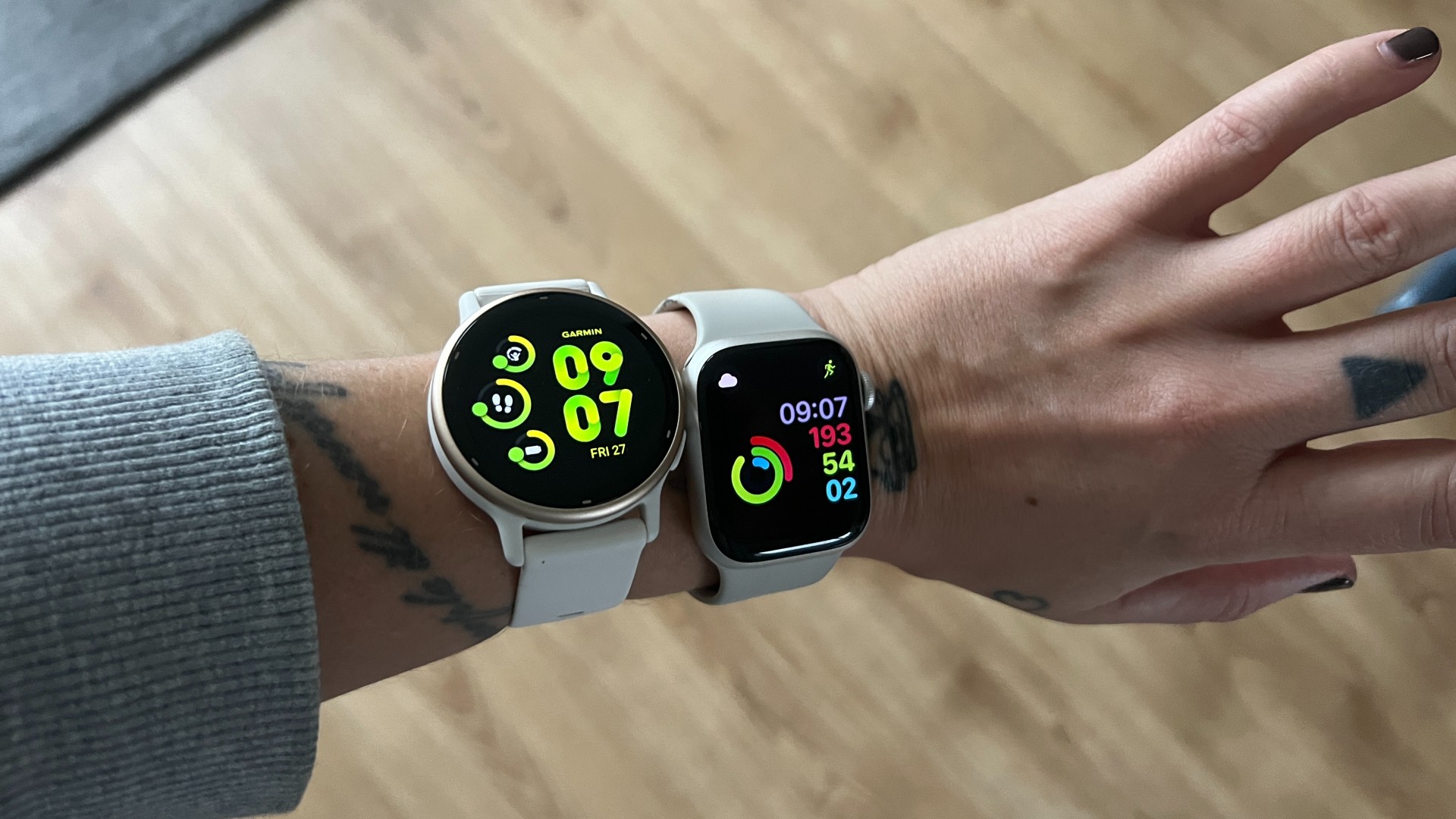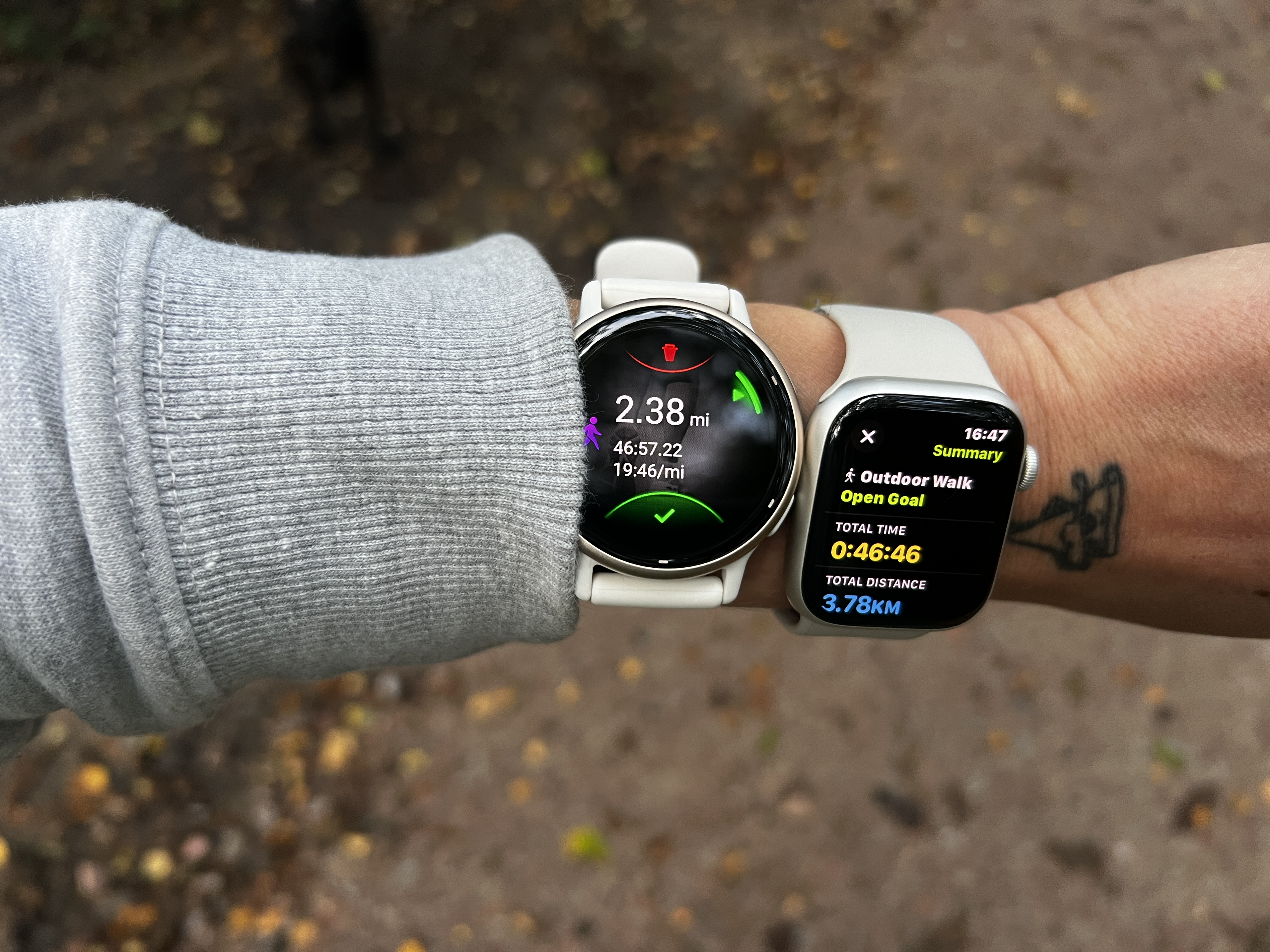
I’ve been curious — would Garmin or Apple track my daily steps most accurately? Keen to find out, I strapped on the Apple Watch Series 7 and the latest Garmin Vivoactive 5 smartwatch and took them for a 5,000-step walk to test them out, comparing which, if either, was more accurate.
Just for the record, I’ve been reviewing the Garmin Vivoactive 5 recently and have worn the Apple Watch Series 7 for some time. Both have wicked features, including calorie burn and heart rate tracking — the Vivoactive 5 has just upgraded to the Elevate V4 heart rate sensor — blood oxygen and respiratory rate monitoring, and on the Apple Watch Series 7, wrist temperature capabilities. That said, neither of these models uses multi-band GPS tracking, which taps into multiple frequencies for more accurate tracking.
So how do two of the best fitness trackers measure steps? The Apple Watch Series 7 and Garmin Vivoactive 5 use internal accelerometers to measure arm swing. One swing counts two steps, but interestingly, Garmin says that holding a leash while walking your pet can reduce the steps recorded. The pooch stays at home this time, then. You’ll also need to ensure the watch sits snug and you’ve set your device to the correct orientation (which wrist you wear it on) beforehand.
Our editor has taken on plenty of step-counting challenges, comparing models like the Apple Watch Series 9 vs Fitbit Charge 6 and the Apple Watch Series 9 vs Garmin Forerunner 265, among others, if you're keen to find out how your favorite model compares. Now it’s my turn to take on the challenge, here’s what happened.
I walked 5,000 steps with the Apple Watch Series 7 and Garmin Vivoactive 5: Here’s which was more accurate
On the advice of my editor, I downloaded the Tally Counter app which allowed me to manually count my steps by clicking as I walked. I checked both devices were configured to my left wrist and wore both watches with a snug fit, using the tally counter with my other hand so that my arm could swing naturally.
I found it pretty ideal, considering I have ADHD and am known to lose my phone three times a day (at least). After 5,000 steps, I stopped and compared results on the Garmin Vivoactive 5 and Apple Watch Series 7 by uploading them to my phone to check the data.

The results
| Total steps | |
| Manual step counter | 5,000 |
| Apple Watch Series 7 | 4,800 |
| Garmin Vivoactive 5 | 5,100 |
My Apple Watch Series 7 recorded 2.35 miles with a moving time of 43:28 and 4,800 steps. The Garmin Vivoactive 5 recorded a walk of 2.38 miles and 5,100 steps. Both recorded my average heart rate as 105 bpm (pretty cool), and the Garmin recorded 208kcal total calorie burn versus 192kcal on the Apple Watch, which is close.
Sign up to get the BEST of Tom's Guide direct to your inbox.
Get instant access to breaking news, the hottest reviews, great deals and helpful tips.
The Garmin Vivoactive 5 had the most accurate results, yet both were further out than I anticipated. That said, no fitness tracker will offer you 100% accuracy and your cadence, height and stride will all play a role.
Garmin and Apple don't make it easy when trying to track your steps during an activity either. You can easily look at your total daily step count from your watch, but to gather the step data from both watches for a recorded activity, I had to re-download Strava and sync the walks to my account. Considering how much data is readily accessible like calorie burn or heart rate, it's a strange oversight that neither seems worried about fixing.
It's also worth remembering that the best smartwatches also track your heart rate, calorie burn and other metrics that can give you a stronger indication of how your health looks, side from step count. And research shows that the magical 10,000 steps per day the media previously touted aren’t quite founded in science, and as many as 7,000 steps could be just as beneficial for your health.
I do find steps helpful though, as it's an easy way to set walking targets if you struggle to clock up movement throughout the day. Focusing your efforts on NEAT (Non-Exercise Activity Thermogenesis) can help you increase your step count, simply taking the stairs over the elevator or walking to the subway can help you move more outside of dedicated exercise. Here’s what 30 minutes of walking each day can do for your body.
It’s also worth understanding what your fitness tracker can get you for your money. Both these devices are brilliant trackers with features like activity rings (the Apple Watch 7) and Garmin Coach training plans (Garmin). If you're looking for a more sports-focused model, many go towards the Garmin Forerunner series or the Garmin Venu 3 for the updated heart rate capabilities, which could cost you more.
For Apple lovers, the Apple Watch Series 8 and Apple Watch Series 9 are also worth considering if you’re looking for an upgrade, and we've reviewed both to help you decide. We recommend keeping your eye on the best Black Friday deals for tech, fitness and more over the coming weeks to see how much money you can save on your favorite Garmin and Apple products, as you might pick up a bargain.
More from Tom's Guide

Sam Hopes is a level 3 qualified trainer, level 2 reiki practitioner and senior fitness writer at Tom's Guide. She is also currently undertaking her Yoga For Athletes training course. Sam has written for various fitness brands and websites over the years and has experience across brands at Future such as Live Science, Fit&Well, Coach, and T3.
Having worked with fitness studios like F45 and Virgin Active, Sam now primarily teaches outdoor bootcamps, bodyweight, calisthenics and kettlebells. She also coaches mobility and stretching-focused classes several times a week and believes that true strength comes from a holistic approach to training your body.
Sam has completed two mixed doubles Hyrox competitions in London and the Netherlands and finished her first doubles attempt in 1:11.
